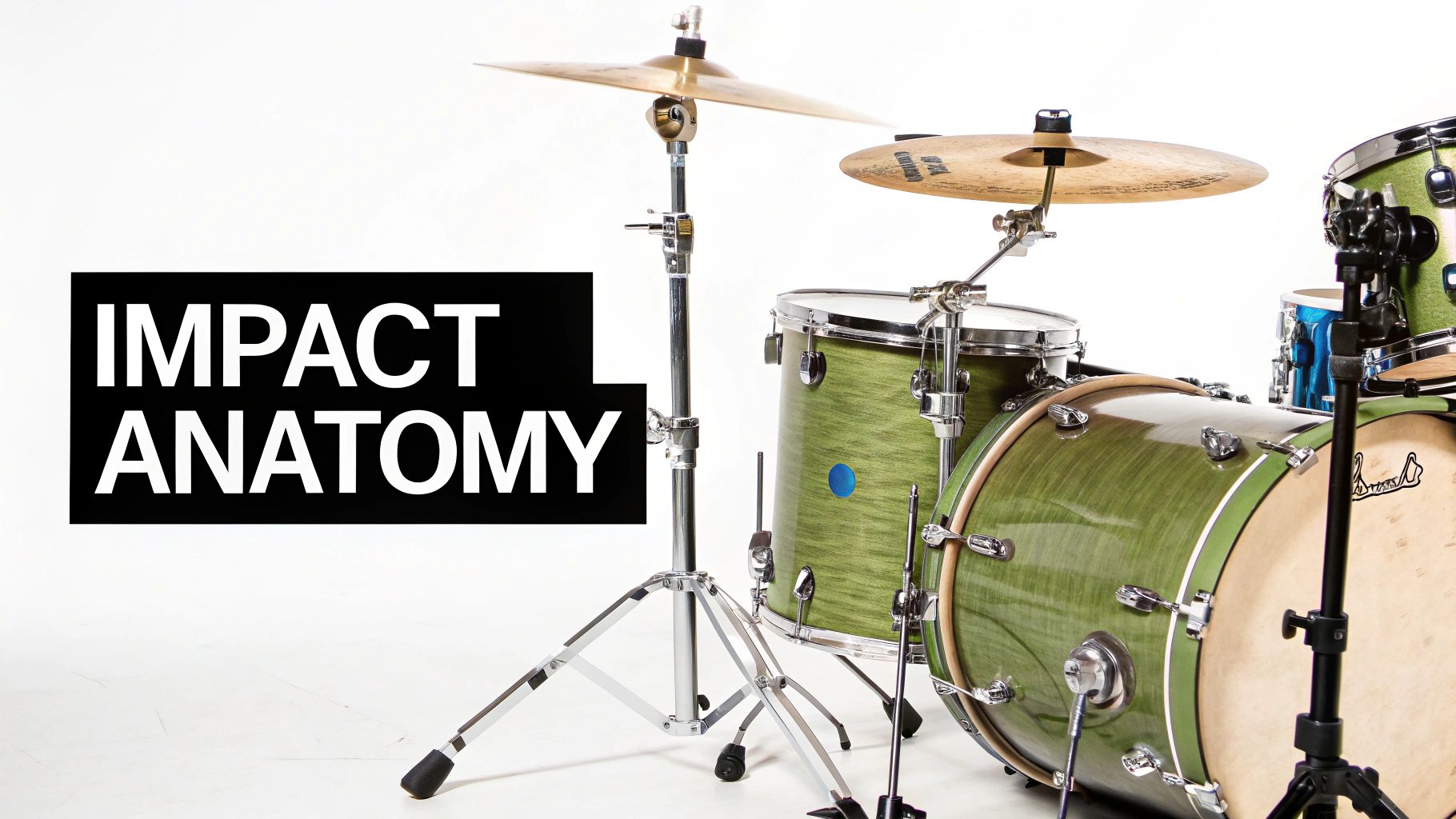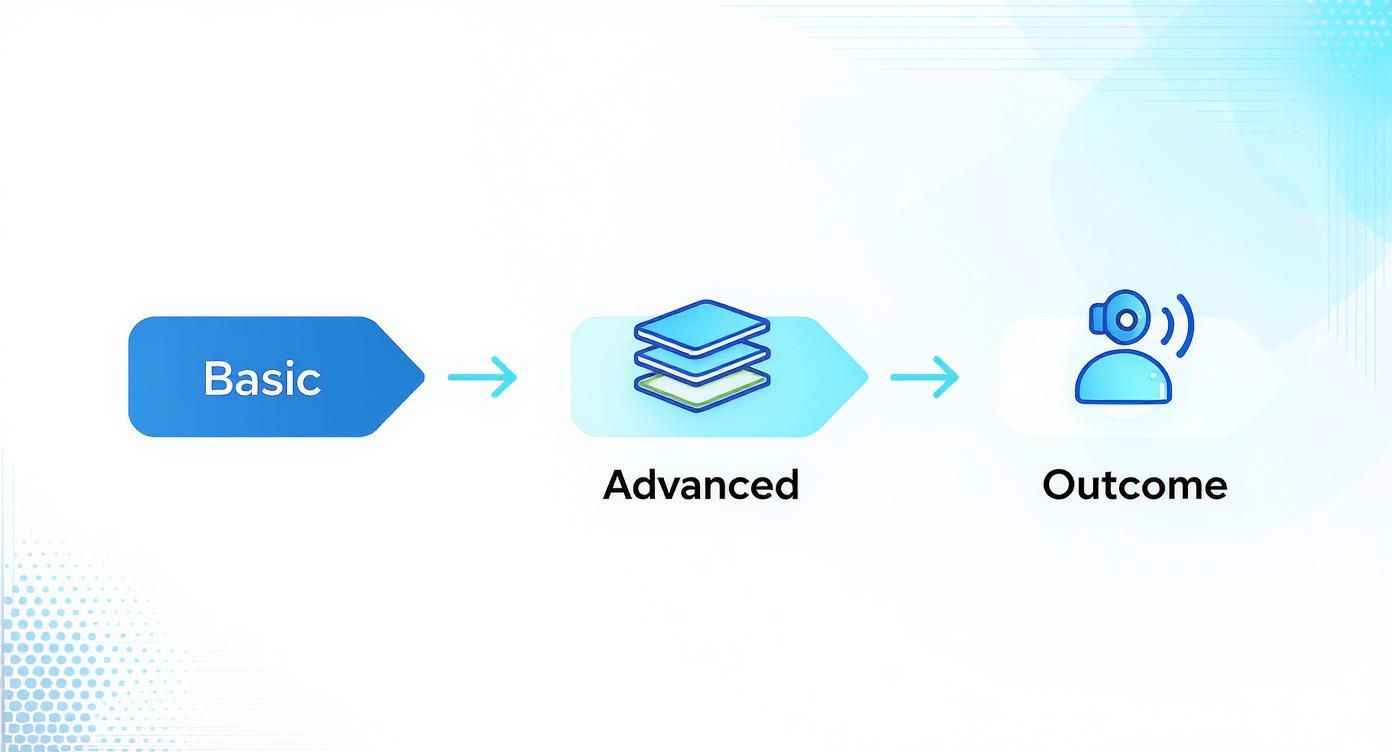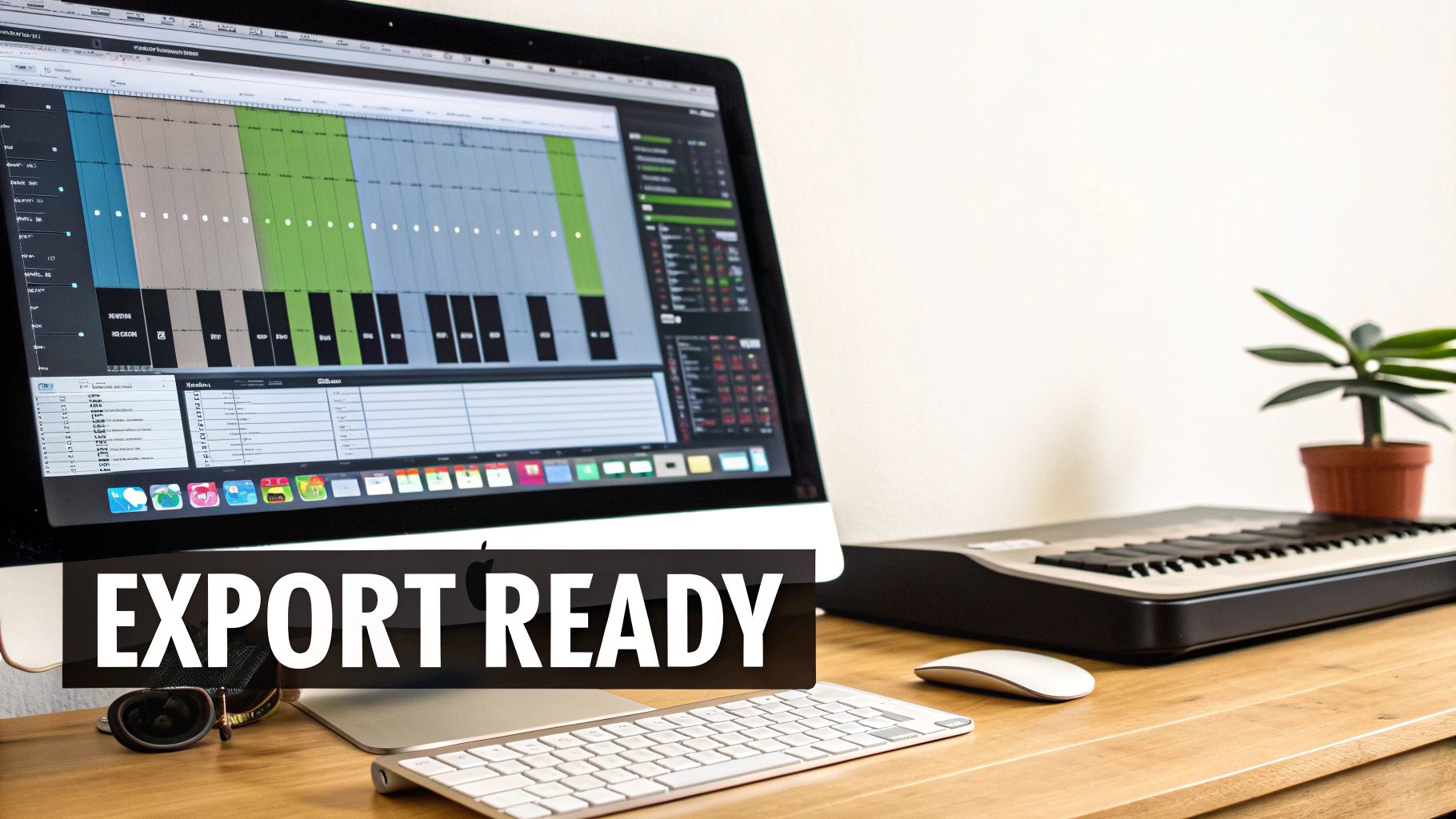
A killer drum sound effect isn't just noise—it's the heartbeat of your project. It adds punch, energy, and a distinct personality. Think about it: a flat, lifeless beat gets ignored, but a powerful, resonant one? Listeners feel that. Getting a handle on what makes a drum sound truly great is your first step to crafting one yourself.

Before you start building, you need to think like a sound designer. A powerful drum sound is a tiny story with a beginning, middle, and end. Each part of that story has a job to do, shaping how the sound hits the ear and the feeling it leaves behind.
It's not just a single, uniform thump. A good drum sound is a blend of key characteristics working in harmony.
There's no single "best" drum sound. The right sound is entirely dependent on where it’s being used. A deep, booming kick might be perfect for an epic movie trailer, but it would sound completely wrong in a chill lo-fi track.
This is where knowing some basic sound design principles is so valuable. It helps you match the sound to the moment.
A great drum sound supports the project's emotional goal. It’s less about perfect realism and more about crafting an intentional feeling—whether that's tension, excitement, or just raw power.
This push for better, more believable sounds is a big deal. The global electronic drum market is on track to hit around $750 million by 2033. This growth is all about new tech making digital sounds almost identical to real acoustic kits. It just goes to show how much demand there is for high-quality, convincing drum sounds across all media.
This is where the magic really happens. If you just type "kick drum" into the engine, you're going to get... well, a generic kick drum. To get those professional, ear-catching sounds, you need to think more like a sound designer and less like you're just searching for a file.
Your words are the raw materials the AI uses to build your sound. Think of it like giving directions—the more specific you are, the more likely you'll end up exactly where you want to go. It’s all about layering details to create a complete sonic picture.
The best way I've found to do this is by building the prompt piece by piece. Start with the absolute core of the sound, then layer on details about what it's made of, where it's being played, and what its overall vibe is.
Each layer you add tells the AI to ignore thousands of other possibilities, steering it directly toward the sound in your head.
Let's break it down with a snare drum:
snare hit.tight, cracking birch snare hit.tight, cracking birch snare hit in a small, carpeted studio.tight, cracking birch snare hit in a small, carpeted studio, with a short punchy decay.This layered method takes you from a vague concept to a precise, actionable instruction. If you're curious about the tech behind this, our guide on how to generate audio from text offers a great deep dive.
The real goal isn't just to describe the sound itself, but the feeling and context around it. Adding a genre or mood—like 'lo-fi hip hop kick' or 'cinematic trailer impact'—gives the AI crucial stylistic clues to work with.
This approach completely changes the game. See for yourself how a little extra detail can transform a basic idea into a fully realized sound.
This table shows just how powerful a well-crafted prompt can be. Notice how the advanced prompts don't just describe the sound, but also its texture, environment, and character.
| Drum Type | Basic Prompt | Advanced Prompt | Expected Outcome |
|---|---|---|---|
| Kick Drum | kick drum | deep, punchy 808 kick drum, heavy sub-bass, slight vinyl crackle, short decay | A classic hip-hop kick with a modern, textured feel and tight low-end. |
| Cymbal | cymbal crash | bright, shimmering 18-inch crash cymbal, explosive attack, long washy decay, recorded in a large hall | A huge, epic cymbal perfect for cinematic moments or powerful rock tracks. |
| Hi-Hat | hi-hat | crisp, metallic closed hi-hat, tight and clean, funk groove, subtle room reverb | A sharp, groovy hi-hat that will cut through a mix without being harsh. |
| Tom Drum | tom hit | deep, resonant floor tom, boomy with a slow decay, struck with a soft mallet, dark and cinematic | A dramatic, low-pitched tom ideal for film scores or ambient soundscapes. |
See the difference? A simple prompt is a gamble, but a detailed one is a clear directive. You're effectively removing the guesswork and getting 90% of the way to your final sound just with your words. Mastering this technique is the single most important step you can take.
Getting a sound from a text prompt is just the starting point. The real magic happens when you start using SFX Engine's parameters to mold that raw audio into a polished, professional drum sound effect. Don't think of these as just simple sliders; they're your tools for surgical sound design, giving you the power to fine-tune every little detail.
This is where you graduate from a good idea to a fantastic execution. A solid prompt gets you in the ballpark, but mastering the parameters is what gives you total control over the final texture, punch, and overall character of your sound.
The first parameter I usually reach for is 'Style'. It's incredibly powerful, allowing you to shift the entire vibe of the sound from a realistic, acoustic feel to something completely synthetic. You could, for example, prompt a realistic snare hit and then push the 'Style' slider toward synthetic to create a cool hybrid sound that sits perfectly in an electronic track.
Next up, let's talk about 'Weight'. For kick drums, this setting is everything. It's your direct control over the low-end presence and punch. If your kick sounds a bit thin or weak, bumping up the weight adds that essential body and impact needed to really drive a beat forward.
This workflow chart breaks down the journey from a basic concept to a fully refined sound.

As you can see, it's an iterative process. You start with a simple prompt, but the AI parameters are where you do the heavy lifting to shape it into something special.
Finally, let's look at the 'Resonance' and 'Decay' sliders. These two parameters are all about shaping the tail end of your drum hit.
By combining smart prompt crafting with precise parameter tweaks, you gain an incredible amount of control. You can get a sound that’s 90% of the way there with just text, then use the sliders to dial in that final 10% of perfection.
This level of customization is more important than ever. While the traditional acoustic drum market is still valued at around $3 billion annually, electronic drums are closing the gap with growth rates between 3–5%. This tells us there's a huge demand for both authentic and hybrid sounds—exactly what you can create by mastering these AI tools.
Knowing how to guide the AI with both words and parameters is a crucial skill. For a deeper dive into optimizing outputs from generative systems, it’s worth exploring the principles of Generative Engine Optimization (GEO). And if you're ready for more hands-on techniques, our complete guide on https://sfxengine.com/blog/how-to-create-sounds has you covered.
https://www.youtube.com/embed/J0IHZ90eA7M
Alright, let's move past simple imitation and start creating sounds that are truly one-of-a-kind. This is where we can build a signature drum sound effect that you just can't get from a traditional kit. The trick is to stop thinking about a drum as a single object and start treating it like a sculpture made of different parts.
A technique I use all the time is creative layering. Instead of asking for a complete "snare," I'll generate its core components separately. Think about creating a sharp, metallic 'transient' for that initial crack, and then a totally separate, deep 'body' for the resonance. When you blend those two pieces together, you have complete control over the final sound.
Another trick of the trade is telling the AI what you don't want. This is where negative prompts come in handy, letting you cut out unwanted sonic clutter before it even gets generated.
Here are a few examples I find myself using often:
Using this approach saves a ton of time on cleanup later. It’s all about being specific from the get-go to steer the AI in the right direction.
The whole point here is to break free from the sounds we've all heard a million times. Don't be afraid to experiment with wild descriptors. I've had incredible results with prompts like 'glass snare,' 'liquid kick drum,' or 'stone tom hit.' This is how you discover textures that will make your projects unforgettable.
This kind of creative power used to be much harder to access, but with so many audio tools now online, it's a different world. It's fascinating to see how the market has shifted; online sales channels now make up about 30% of all drum and percussion sales worldwide.
That digital shift has really driven the demand for unique, high-quality drum sound effects as more producers build their entire sound libraries in the box. You can read more about the drum market trends on cognitivemarketresearch.com. Mastering these techniques puts you right at the heart of modern sound design.

Getting that killer sound is a great feeling, but it's only part of the job. The real magic happens when you seamlessly integrate that sound into your project. Getting the export and integration right is what makes a raw audio file feel like a professional drum sound effect that truly elevates your track.
The first decision you'll make is the file format, and it's a big one. For anything high-fidelity, like music production or film sound design, WAV is your go-to. It’s a lossless format, which means you get every single detail of the original audio, giving you the best possible quality to work with later.
On the other hand, if you're creating sounds for a game, a website, or any situation where file size is critical, MP3 is often the more practical route. You'll sacrifice a bit of audio quality due to the compression, but the file size will be much more manageable.
Before you even think about hitting that export button, take a moment to run through a quick checklist. Trust me, a few seconds here can save you a world of frustration down the line.
A well-prepared sound effect slots into a project seamlessly. Think of it like a puzzle piece—if it’s the right shape and size from the start, you won’t have to force it to fit into the final picture.
Once your sound is exported, the final polish happens in your digital audio workstation (DAW) or video editor. This is where you can make those tiny adjustments that make a huge difference. A touch of EQ can help the drum sound find its own space in a crowded mix. For example, scooping out a bit of the low-mids can keep it from fighting with a bassline or muddying up dialogue.
It’s these final touches that ensure your custom drum sound contributes to a clean, professional, and powerful result.
Once you dive into making custom drum sound effects with AI, you're bound to have questions. It's a new way of working, after all. Let's walk through some of the common things I hear from people so you can get past any roadblocks and really start leveraging SFX Engine to its fullest potential.
The whole game is about refining your process. You'll be surprised how a few small changes in your prompting and tweaking can completely change the quality of the sounds you get.
The fastest way to get away from generic sounds is to get specific. Way more specific. Instead of just asking for a kick drum, describe what you really want. Think about its texture, its environment, and its job in the track.
A much stronger prompt looks something like this: Deep 808 kick drum with a soft attack and long sub-bass decay, perfect for trap music.
But don't stop there. Once you have a good starting point, the parameter controls are your best friend for dialing in the exact texture, weight, and resonance. I also love to layer multiple generated sounds. You can grab the sharp, snappy attack from one and blend it with the long, resonant body of another to build a drum hit that is 100% yours.
My best sounds almost always come from layering. Combining the crisp transient of one generation with the deep body of another lets you create a drum hit with a unique power that you'll just never find in a standard sample pack.
When you're aiming for a full kit, my advice is to build it one piece at a time. Generate your kick, your snare, your hi-hats, and your cymbals all with their own dedicated, detailed prompts. This gives you granular control over every single element.
The trick to making them all sound like they belong together is to use a consistent "unifying" descriptor in every prompt. Words like acoustic jazz kit or vintage drum machine act as a creative anchor, telling the AI to maintain a specific sonic character across all the different pieces.
For example, you could build a perfectly matched set using prompts like:
Vintage drum machine snare, punchy with a short decayVintage drum machine kick, round and bass-heavyVintage drum machine closed hi-hat, crisp and metallicGetting an exact 1-to-1 match is the holy grail, and while it's challenging, you can get incredibly close with a descriptive prompt. The key is to listen—really listen—to the sound you're trying to copy.
Break it down. What are its core qualities? Is it punchy or soft? Is it drenched in reverb? What's the pitch like?
Jot those notes down and turn them into your prompt. Something like: Tight, high-pitched snare hit with heavy reverb, similar to a 1980s pop song. From there, it's all about using the parameter controls to fine-tune the result until it sits just right.
For drums that cut through a busy track, you need to focus on two things: the transient and the mid-range frequencies.
When you're writing the prompt, use words that emphasize that initial impact. Think "punchy," "sharp attack," or "aggressive transient."
After you've generated the sound, try bumping up the 'Weight' parameter to give it more body and presence. Then, once you pull the sound into your DAW, a touch of compression can really make that initial hit pop, and a gentle EQ boost in the 1-3 kHz range will help it slice through the rest of the instruments.
Ready to stop endlessly scrolling through sample packs? SFX Engine gives you the power to generate countless royalty-free drum sounds that are made specifically for your project. Start creating for free today at sfxengine.com.